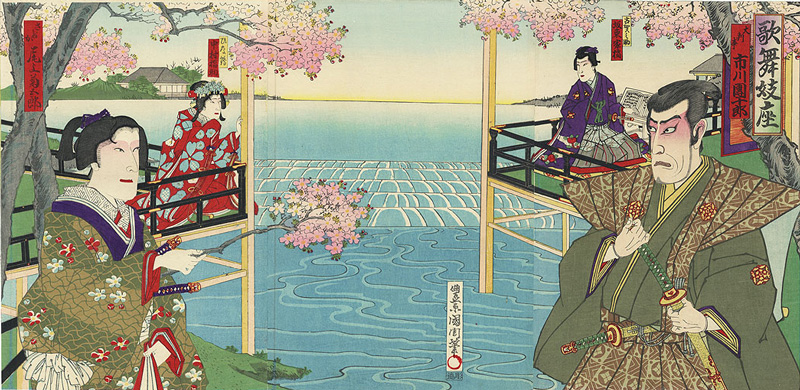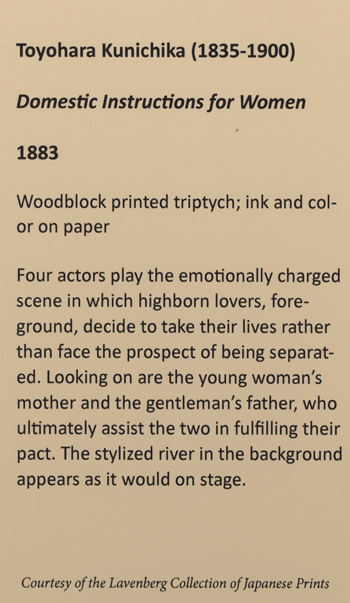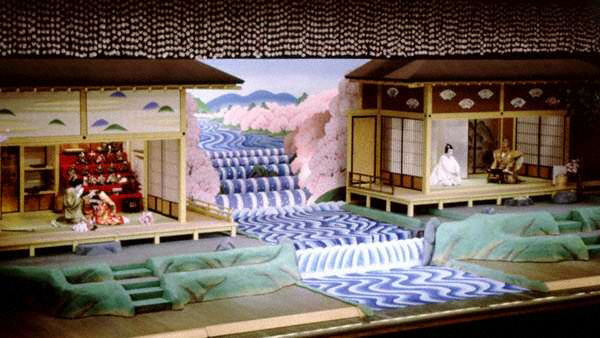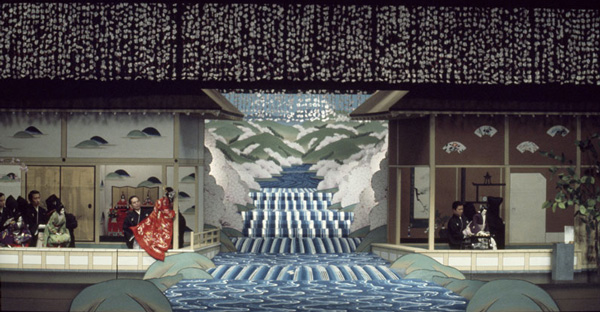About This Print
Kunichika depicts the famous scene Yoshinogawa from the third act of the drama Imoseyama Onna Teikin, performed at the Shitomi-za in October 1883. In this scene the young samurai Koganosuke and the beautiful Hinadori decide that they would rather commit suicide than be separated. They exchange glances from their separate verandas on opposite sides of the Yoshino River as Hinadori's widowed mother Dazai Kōshitsu Sadaka and Koganosuke's father Daihanji Kyozumi hold sprigs of cherry blossoms, symbols of their intentions.Kunichika's depiction of the Yoshino River replicates how the river appears in the kabuki theater through the stage device called takiguruma (waterfall wheels) in which the river painted in bright blue and white appears to be flowing out from the back of the stage toward the audience. (See photo below under the heading "Stage Sets for Kabuki and Bunraku.")
For another print related to this October performance of the play see IHL Cat. #1001.
The Actors Pictured in This Collection's Print
from right to left:
Nakamura Shikan IV 市川団十郎 in the role of Daihanji no Kyozumi 大判司清澄
Ichikawa Sadanji 市川左団次 in the role of Koganosuke 久我之介
Ichikawa Danjūrō IX 市川団十郎 in the role of Dazai Kōshitsu Sadaka 貞高後室
Nakamura Fukusuke IV 中村福介 in the role of Hinadori 雛どり
For profiles of the actors please see the article The Kabuki Actor.
The power struggle between the Soga and the Fujiwara clans in the seventh century is the background to this play that deals with the virtue of self-sacrifice in women. The story of the doomed love amid blossoming cherry trees and the wonderful display of puppets during the Girls’ Festival made the play appealing to servant girls. It was usually staged during their annual holiday in the cherry blossom season. During the performance the stage is divided in two, each with its own chorus and play.1
The Yoshinogawa scene pictured in this print is a Romeo and Juliet-type story about the lovers Koganosuke and Hinadori, the handsome son of Daihanji no Kiyozumi and the beautiful daughter of the widow Sadaka, whose parents have been feuding over the boundary between their territories.
The stage set is both unique and gorgeous. It is the only kabuki play in which two hanamichi runways are used. Each one leads to the main stage, which has a river flowing down the center, flanked by cherry trees in full bloom. On either side of the river are the houses of the two clans. To the left is the home of the widow Sadaka and her daughter Hinadori, in which the walls are painted cream, the doors gold, and a vivid red Dolls' Festival display dominates the living room. To the right is the mansion of Daihanji and his son Koganosuke. Here the walls are a rich brown, and silver screens adorn the main room. Cherry blossoms hang from above the stage and are painted on the wings of the set, creating a frame of pink around the stage.
As the scene opens, the two young people are in their respective homes: Koganosuke is reading Buddhist scriptures alone in his father's house at the foot of Mount Seyama in Kii Province (Wakayama Prefecture), Hinadori is celebrating the Doll Festival with her attendants in her mother's house at the foot of Mount Imoyama in Yamato Province. They are pining for each other, but are separated by the Yoshino River painted in bright blue and white, which appears to be flowing out from the back of the stage toward the audience by the use of a stage device called takiguruma (waterfall wheels).
Daihanji and Sadaka appear on stage and greet each other courteously. The pair are suspected by Iruka of hiding Lady Uneme, the emperor's consort, whom Iruka wants to marry because she is the daughter of his political enemy Kamatari. Daihanji has been pondering having Koganosuke commit seppuku in order to avert Iruka's suspicion, as the young man helped Lady Uneme go into hiding. Sadaka, ordered by Iruka to give him her daughter Hinadori to be his mistress, has considered killing Hinadori and presenting her head to Iruka.
When Sadaka hears that Hinadori would indeed prefer to die rather than go to Iruka, she beheads her daughter with a single stroke and sends the severed head, in a miniature palanquin, across the river to be united with Koganosuke, who has just stabbed himself. Seeing his dying son cradle Hinadori's head, Daihanji administers him the final, decapitating blow.
1 Heroes of the Kabuki Stage: An Introduction to the World of Kabuki with Retellings of Famous Plays, illustrated by Woodblock Prints, Arendie Herwig and Henk J. Herwig, Hotei Publishing, 2004, p.231.
Print of an 1899 Performance of Imoseyama Onna Teikin
The below print, picturing the same scene from the play, was created by Kunichika for an 1899 performance at the Kabuki-za theater. Imoseyama Onna Teikin, 1899
Staged at the Kabukiza 歌舞伎座 in 1899 with (from right to left)
Ichikawa Danjūrō IX as Daihanji Kyozumi; Bandō Kakitsu II as Koganosuke;
Onoe Kikugorō V as Dazai Kōshitsu Sadaka and Nakamura Fukusuke IV as Hinadori

Staged at the Kabukiza 歌舞伎座 in 1899 with (from right to left)
Ichikawa Danjūrō IX as Daihanji Kyozumi; Bandō Kakitsu II as Koganosuke;
Onoe Kikugorō V as Dazai Kōshitsu Sadaka and Nakamura Fukusuke IV as Hinadori
Caught in the Act: Woodblock Kabuki Prints from the Lavenberg Collection of Japanese Prints
July 29 - September 3, 2017 in the Tanabe Gallery at the Portland Japanese Garden

become Tokyo, when Japan was modernizing rapidly. New technology introduced from the West meant the introduction of brilliant colors derived from synthetic dyes that smacked of evolving times. Even so, traditions in kabuki print design remained: details masterfully rendered; cartouches giving the actor's name and role; the action unfolding across multiple sheets of paper.
The Actors Pictured in This Collection's Print
from right to left: Nakamura Shikan IV 市川団十郎 in the role of Daihanji no Kyozumi 大判司清澄
Ichikawa Sadanji 市川左団次 in the role of Koganosuke 久我之介
Ichikawa Danjūrō IX 市川団十郎 in the role of Dazai Kōshitsu Sadaka 貞高後室
Nakamura Fukusuke IV 中村福介 in the role of Hinadori 雛どり
For profiles of the actors please see the article The Kabuki Actor.
The Play "Imoseyama Onna Teikin"
Sources: Kabuki 21 website http://www.kabuki21.com/iot.php and as footnoted.The power struggle between the Soga and the Fujiwara clans in the seventh century is the background to this play that deals with the virtue of self-sacrifice in women. The story of the doomed love amid blossoming cherry trees and the wonderful display of puppets during the Girls’ Festival made the play appealing to servant girls. It was usually staged during their annual holiday in the cherry blossom season. During the performance the stage is divided in two, each with its own chorus and play.1
The Yoshinogawa scene pictured in this print is a Romeo and Juliet-type story about the lovers Koganosuke and Hinadori, the handsome son of Daihanji no Kiyozumi and the beautiful daughter of the widow Sadaka, whose parents have been feuding over the boundary between their territories.
The stage set is both unique and gorgeous. It is the only kabuki play in which two hanamichi runways are used. Each one leads to the main stage, which has a river flowing down the center, flanked by cherry trees in full bloom. On either side of the river are the houses of the two clans. To the left is the home of the widow Sadaka and her daughter Hinadori, in which the walls are painted cream, the doors gold, and a vivid red Dolls' Festival display dominates the living room. To the right is the mansion of Daihanji and his son Koganosuke. Here the walls are a rich brown, and silver screens adorn the main room. Cherry blossoms hang from above the stage and are painted on the wings of the set, creating a frame of pink around the stage.
As the scene opens, the two young people are in their respective homes: Koganosuke is reading Buddhist scriptures alone in his father's house at the foot of Mount Seyama in Kii Province (Wakayama Prefecture), Hinadori is celebrating the Doll Festival with her attendants in her mother's house at the foot of Mount Imoyama in Yamato Province. They are pining for each other, but are separated by the Yoshino River painted in bright blue and white, which appears to be flowing out from the back of the stage toward the audience by the use of a stage device called takiguruma (waterfall wheels).
Daihanji and Sadaka appear on stage and greet each other courteously. The pair are suspected by Iruka of hiding Lady Uneme, the emperor's consort, whom Iruka wants to marry because she is the daughter of his political enemy Kamatari. Daihanji has been pondering having Koganosuke commit seppuku in order to avert Iruka's suspicion, as the young man helped Lady Uneme go into hiding. Sadaka, ordered by Iruka to give him her daughter Hinadori to be his mistress, has considered killing Hinadori and presenting her head to Iruka.
When Sadaka hears that Hinadori would indeed prefer to die rather than go to Iruka, she beheads her daughter with a single stroke and sends the severed head, in a miniature palanquin, across the river to be united with Koganosuke, who has just stabbed himself. Seeing his dying son cradle Hinadori's head, Daihanji administers him the final, decapitating blow.
1 Heroes of the Kabuki Stage: An Introduction to the World of Kabuki with Retellings of Famous Plays, illustrated by Woodblock Prints, Arendie Herwig and Henk J. Herwig, Hotei Publishing, 2004, p.231.
Stage Sets for Kabuki and Bunraku
| Imoseyama Onna Teikin Yoshinogawa Heisei 3 (1992) April, Kabukiza Theater ©Nihonhaiyukyokai/Aoki Shinji http://web-japan.org/museum/kabuki/kabuki01/kabuki_02_01.html | The Teachings for Women Imoyama and Seyama Mansions, May 1977 Production 1977 May14, Kokuritsu shōgekijō, Bunraku, Imoseyama onna teikin Piece Imoseyama onna teikin Copyright 1998-2008, Global Performing Arts Consortium. All Rights Reserved. Courtesy of The Barbara Curtis Adachi Bunraku Collection, C.V. Starr East Asian library, Columbia University. |
Print Details
| IHL Catalog | #597 |
| Title (Description) | Imoseyama Onna Teikin (variously translated as Imoseyama, Domestic Instructions for Women, An Example of Womanly Virtue; A girl sacrificed at Imoseyama; Admonitions to Women on Their Relationships with Men; The Teachings for Women Imoyama and Seyama Mansions) 妹背山婦女庭訓 いもせやまおんなていきん |
| Artist | Toyohara Kunichika (1835–1900) |
| Signature | Toyohara Kunichika hitsu |
| Seal | Toshidama seal beneath artist's signature |
| Publication Date | September 29, 1883 明治十六年九月二十九日 |
| Publisher |  |
| Carver | no carver seal |
| Impression | excellent |
| Colors | excellent |
| Condition | good- unbacked; three sheets joined, light wrinkling |
| Genre | ukiyo-e; yakusha-e |
| Miscellaneous | |
| Format | vertical oban triptych |
| H x W Paper | 14 x 27 3/4 in. (35.6 x 70.5 cm) |
| Literature | |
| Collections This Print | Tokyo Metropolitan Library M348-044-08(01), (02), (03); The Tsubouchi Memorial Theatre Museum of Waseda University 100-2907 100-2906 100-2905 |







